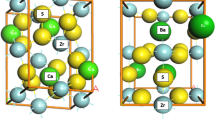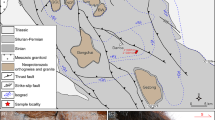Abstract
Dehydration of hydrous minerals is the key for understanding the partial melting and earthquakes taking place at subduction zones. It has been reported that a large amount of H2O defects (HD) can be formed during the dehydration process. However, the HD effects on the properties of hydrous minerals have never been considered previously. In this work, density functional theory (DFT) calculations were carried out to study the formation enthalpies of HD in lizardite. The calculated formation enthalpies of lizardite with 0.8125 wt% HD are below 0.5 eV at pressures from 0 to 7 GPa, which are low enough for the formation of HD, especially at high temperature. The presence of HD exerts significant influence on the elastic property of lizardite, resulting in lower seismic velocities and obviously higher seismic velocity anisotropy. We also calculated the migration barrier energy of H+, Mg2+, and Si4+ in lizardite. H+ migration barrier energy is 1.16 eV (vertical with ‹001› direction) and 3.40 eV (along ‹001› direction) at the pressure of 3 GPa, while Mg and Si present much higher values of more than 5 and 9 eV, respectively. Further simulations of first-principles molecular dynamics (FPMD) on lizardite with and without HD indicate that the crystal structure of HD-bearing lizardite is thermodynamically stable, and proton conduction is not obvious in lizardite and HD-bearing lizardite at temperatures below 900 K and pressures below 2 GPa.









Similar content being viewed by others
References
Abramson E, Brown J, Slutsky L, Zaug J (1997) The elastic constants of San Carlos olivine to 17 GPa. J Geophys Res 102:12253–12263
Anderson D (1989) Theory of the earth blackwell scientific. Mass, Boston
Auzende A, Guillot S, Devouard B, Baronnet A (2006) Behaviour of serpentinites in convergent context: microstructural evidence. Eur J Mineral 18:21–33
Auzende A, Escartin J, Walte N, Guillot S, Hirth G, Frost D (2015) Deformation mechanisms of antigorite serpentinite at subduction zone conditions determined from experimentally and naturally deformed rocks. Earth Planet Sci Lett 411:229–240
Brindley G, Zussman J (1957) A structural study of the thermal transformation of serpentine minerals to forsterite. Am Miner 42(7–8):461–474
Bühl M, Kabrede H (2006) Acidity of Uranyl (VI) Hydrate Studied with first-principles molecular dynamics simulations[J]. ChemPhysChem 7(11):2290–2293
Campione M, Capitani G (2013) Subduction-zone earthquake complexity related to frictional anisotropy in antigorite[J]. Nature Geosci 6(10):847
Caruso L, Chernosky J (1979) The stability of lizardite. Can Mineral 17(4):757–769
Christensen N (2004) Serpentinites, peridotites, and seismology. Int Geol Rev 46(9):795–816
Dlugogorski B, Balucan R (2014) Dehydroxylation of serpentine minerals: implications for mineral carbonation. Renew Sustain Energy Rev 31:353–367
Dungan M (1979) A microprobe study of antigorite and some serpentine pseudomorphs. Can Mineral 17:771–784
El-Salaam K, Gabr R, Said A (1979) Sintering studies on Mg (OH) 2. Surf Technol 9(6):427–433
Evans B (1977) Metamorphism of alpine peridotite and serpentinite. Ann Rev Earth Planet Sci 5:397–447
Evans B (2004) The serpentinite multisystem revisited: chrysotile is metastable. Int Geol Rev 46:479–506
Freund F, Sperling V (1976) A magnesium oxide defect structure of N ~ Yagonal symmetry. Mat Res Bull 11:621–630
Frost B (1975) Contact metamorphism of serpentinite, chloritic blackwall and rodingite at Paddy-Go-Easy Pass. Central Cascades, Washington. l. Petrologp 16:272–313
Govier D, Arnold M (2004) Quantitative differential thermal analysis of antigorite and lizardite serpentine. Internal Report, Albany Research Center Analytical Laboratory
Guo X, Yoshino T, Katayama I (2011) Electrical conductivity anisotropy of deformed talc rocks and serpentinites at 3 GPa. Phys Earth Planet Inter 188:69–81
He Yu, Sun Yang, Xia Lu, Gao Jian, Li Hong, Li Heping (2016) First-principles prediction of fast migration channels of potassium ions in KAlSi3O8 hollandite: implications for high conductivity anomalies in subduction zones. Geophys Res Lett 43:6228–6233
Henkelman G, Uberuaga B, Jonsson H (2000) A climbing image nudged elastic band method for finding saddle points and minimum energy paths. J Chem Phys 113:9901–9904
Hilairet N, Daniel I, Raynard B (2006) P-V equation of state and the relative stabilities of serpentine varieties. Phys Chem Minerals 33:629–637
Hill R (1952) The elastic behaviour of a crystalline aggregate. Proc Phys Soc Sect A 65:349
Hyndman R, Peacock S (2003) Serpentinization of the forearc mantle. Earth Planet Sci Lett 212:417–432
Iwamori H (1998) Transportation of H2O and melting in subduction zones. Earth Planet Sci Lett 160:65–80
Karato S (1990) The role of hydrogen in the electrical conductivity of the upper mantle[J]. Nature 347(6290):272
Karki B, Stixrude L, Clark S, Warren M, Ackland G, Crain J (1997) Structure and elasticity of MgO at high-pressure. Am Mineral 82:51–60
Karki B, Stixrude L, Wentzcovitch R (2001) High-pressure elastic properties of major minerals of the Earth’s mantle from first-principles. Rev Geophys 39:507–534
Katayama I, Hirauchi K, Michibayashi K, Ando J (2009) Trench-parallel anisotropy produced by serpentine deformation in the hydrated mantle wedge[J]. Nature 461(7267):1114
Kohn W, Sham L (1965) Self-consistent equations including exchange and correlation effects. Phys Rev A 140:1133–1138
Kresse G, Furthmüller J (1996) Efficient iterative schemes for ab initio total-energy calculations using a plane-wave basis set. Phys Rev B 54:11169–11186
Long M, van der Hilst R (2006) Shear wave splitting from local events beneath the Ryukyu arc: trench-parallel anisotropy in the mantle wedge[J]. Phys Earth Planet Inter 155(3–4):300–312
Mainprice D, Hielscher R, Schaeben H (2011) Calculating anisotropic physical properties from texture data using the MTEX open-source package[J]. Geol Soc Lond Spec Publ 360(1):175–192
McKelvy M, Sharma R, Chizmeshya A, Carpenter R, Streib K (2001) Magnesium hydroxide dehydroxylation: in situ nanoscale observations of lamellar nucleation and growth. Chem Mater 13(3):921–926
McKelvy M, Chizmeshya A, Squires K, Carpenter R, Béarat H (2006) A novel approach to mineral carbonation: enhancing carbonation while avoiding mineral pretreatment process cost. Arizona State University, Tempe
Mellini M, Zanazzi P (1989) Effects of pressure on the structure of lizardite-1T. Eur J Mineral 1:13–19
Mookherjee M, Capitani G (2011) Trench parallel anisotropy and large delay times: elasticity and anisotropy of antigorite at high pressures[J]. Geophys Res Lett 38:L09315
Mookherjee M, Mainprice D (2014) Unusually large shear wave anisotropy for chlorite in subduction zone settings. Geophys Res Lett 41:1506–1513
Mookherjee M, Stixrude L (2009) Structure and elasticity of serpentine at high-pressure. Earth Planet Sci Lett 279:11–19
Mookherjee M, Tsuchiya J (2015) Elasticity of superhydrous phase, B, Mg10Si3O14 (OH) 4[J]. Phys Earth Planet Inter 238:42–50
Nakajima J, Hasegawa A (2004) Shear-wave polarization anisotropy and subduction- induced flow in the mantle wedge of northeastern Japan. Earth Planet Sci Lett 225:365–377
Nakajima J, Shimizu J, Hori S, Hasegawa A (2006) Shear-wave splitting beneath the southwestern Kurile arc and northeastern Japan arc. Geophys Res Lett 33:L05305
Nakamura M, Yoshida Y, Zhao D, Katao H, Nishimura S (2003) Three-dimensional P- and S-wave velocity structures beneath the Ryukyu arc. Tectonophysics 369:121–143
Padrón-Navarta J, Tommasi A, Garrido C, Lopez Sanchez V, Gomez-Pugnaire M, Jabaloy A, Vauchez A (2010) Fluid transfer into the wedge controlled by high-pressure hydrofracturing in the cold top-slab mantle. Earth Planet Sci Lett 297:271–286
Peacock S (1990) Fluid processes in subduction zones. Science 248:329–337
Peacock SM, Hyndman RD (1999) Hydrous minerals in the mantle wedge and the maximum depth of subduction thrust earthquakes. Geophys Res Lett 26(16):2517–2520
Perdew J, Zunger A (1981) Self-interaction correction to density functional approximations for many-electron systems. Phys Rev B 23:5048–5079
Reuss A (1929) Berechnung der Fliebgrenze von Mischkristallen auf Grund der Plastizita¨tsbedingung fu¨ r Einkristalle. Z Angew Math Mech 9:49–58
Reynard B (2013) Serpentine in active subduction zones. Lithos 178:171–185
Reynard B, Mibe K, Van de Moortele B (2011) Electrical conductivity of the serpentinised mantle and fluid flow in subduction zones. Earth Planet Sci Lett 307:387–394
Schwartz S, Guillot S, Reynard B, Lafay R, Debret B, Nicollet C, Auzende A (2013) Pressure–temperature estimates of the lizardite/antigorite transition in high pressure serpentinites[J]. Lithos 178:197–210
Seipold U, Schilling F (2003) Heat transport in serpentinites. Tectonophysics 370(1–4):147–162
Seno T (1988) Tectonic evolution of the west Philippine basin[J]. Modern Geology 12:481–495
Seno T, Zhao D, Kobayashi Y, Nakamura M (2001) Dehydration of serpentinized slab mantle: seismic evidence from southwest Japan. Earth Planet Space 53(9):861–871
Tsuchiya J (2013a) A first-principles calculation of the elastic and vibrational anomalies of lizardite under pressure. Am Mineral 98(11–12):2046–2052
Tsuchiya J (2013b) First principles prediction of a new high-pressure phase of dense hydrous magnesium silicates in the lower mantle. Geophys Res Lett 40(17):4570–4573
Tsuchiya J, Tsuchiya T (2009a) Elastic properties of δ-AlOOH under pressure: first principles investigation. Phys Earth Planet Inter 174(1–4):122–127
Tsuchiya J, Tsuchiya T (2009b) First-principles investigations on the elastic and vibrational properties of hydrous wadsleyite under pressure. Geochimica et Cosmochimica Acta Supplement 73:A1350
Tsuchiya J, Tsuchiya T, Tsuneyuki S, Yamanaka T (2002) First principles calculation of a high-pressure hydrous phase, δ-AlOOH. Geophys Res Lett 29(19):15-1
Tsuchiya J, Tsuchiya T, Tsuneyuki S (2005) First-principles study of hydrogen bond symmetrization of phase D under high pressure. Am Mineral 90(1):44–49
Tyburczy J, Duffy T, Ahrens T, Lange M (1991) Shock wave equation of state of serpentine to 150 GPa: implications for the occurrence ofwater in the Earth’s lower mantle. J Geophys Res 96:18011–18027
Voigt W (1928) Lehrbuch der kristallphysik[M]. Leipzig, Teubner, pp 962
Wang D, Mookherjee M, Xu Y et al (2006) The effect of water on the electrical conductivity of olivine[J]. Nature 443(7114):977
Wang Z, Huang R, Huang J et al (2008) P-wave velocity and gradient images beneath the Okinawa Trough[J]. Tectonophysics 455(1–4):1–13
Weber J, Greer R (1965) Dehydration of serpentine: heat of reaction and reaction kinetics at PH 2 O = 1 ATM. Am Miner 50(3–4):450–464
Whittaker E, Zussman J (1956) The characterization of serpentine minerals by X-ray diffraction. Mineral Mag J Mineral Soc 31(233):107–126
Zhu M, Xie H, Guo J, Bai W, Wu Z (2001) Impedance spectroscopy analysis on electrical properties of serpentine at high pressure and high temperature. Sci China Ser D-Earth Sci 44:336–345
Acknowledgements
We acknowledge the support of National Natural Science Foundation of China (Grant no. 41774101). We are grateful to Professors Taku Tsuchiya and two anonymous reviewers for valuable comments and precious advice. We thank Editage for the provided service of English editing.
Author information
Authors and Affiliations
Corresponding author
Additional information
Publisher's Note
Springer Nature remains neutral with regard to jurisdictional claims in published maps and institutional affiliations.
Electronic Supplementary Material
Below is the link to the electronic supplementary material.
Rights and permissions
About this article
Cite this article
Sun, S., He, Y. First-principles investigations on the formation of H2O defects in lizardite with influence on the elastic property. Phys Chem Minerals 46, 935–946 (2019). https://doi.org/10.1007/s00269-019-01052-y
Received:
Accepted:
Published:
Issue Date:
DOI: https://doi.org/10.1007/s00269-019-01052-y




